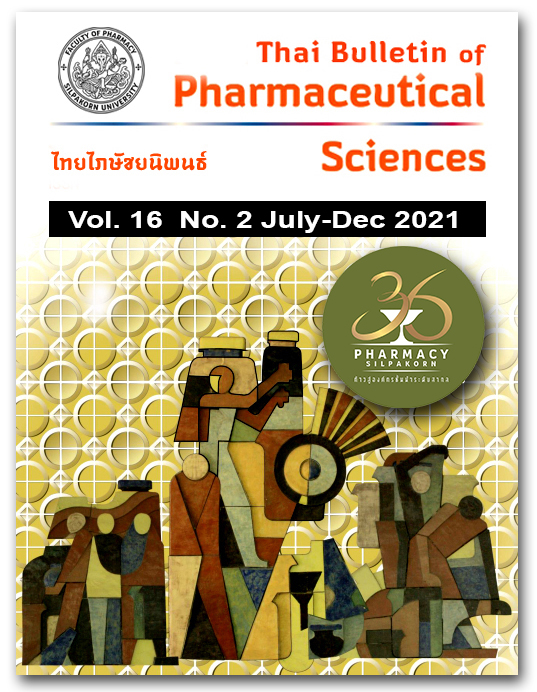CLINICAL OUTCOMES OF ALTEPLASE IN ACUTE ISCHEMIC STROKE PATIENTS AT NAN HOSPITAL
DOI:
https://doi.org/10.69598/tbps.16.2.33-45Keywords:
acute ischemic stroke, fibrinolytic agent, good clinical outcome, symptomatic intracranial hemorrhageAbstract
The trend of ischemic stroke in Thailand has increased. Alteplase is registered as a thrombolytic agent for the treatment of acute ischemic stroke, in case of an onset of symptoms is not more than 3-4.5 hours. This study aimed to determine the clinical outcomes of alteplase in acute ischemic stroke patients. This study was a retrospective cohort study that was conducted among acute ischemic stroke patients admitted at Nan hospital between January 2012 and December 2019. A total of 246 patients were included. There were classified to one hundred and forty-two patients were in alteplase group and 104 patients were not received alteplase. The results showed that at 24 hours, 48.94% of patients in alteplase group had a favorable outcome (NIHSS score was declined greater than or equal to 4 points) compared with 26.51% in patients without alteplase [OR 2.66 (95%CI 1.48-4.97), p-value = 0.001]. When followed up at 1, 3 and 6 months the results showed that good clinical outcomes (Barthel index was greater than or equal to 95 points) did not significantly different between the alteplase and non-alteplase groups [OR 1.69 (95%CI 0.88-3.23), p-value=0.140, OR 1.54 (95%CI 0.71-3.38), p-value=0.322 and OR 2.14 (95%CI 0.93-4.93), p-value=0.091), respectively]. But the number of patients treated with alteplase who had Modified Rankin Scale 0-1 at discharge was significantly higher than those treated without alteplase [OR 3.40 (95%CI 1.76-6.54, p-value =0.000)]. In terms of side effect, the percentage of intracerebral hemorrhage was higher in alteplase group (19.01%) than non-alteplase group treated (2.88%), statistically significant [OR 7.90 (95% CI 2.33-26.84, p-value =0.000)]. Therefore, alteplase in acute ischemic stroke patients could reduce severity and disability of the patients. However, intracerebral hemorrhage should be closely monitored.
References
Prasat Neurological Institute. Clinical Practice Guidelines for ischemic stroke. Bangkok: The Institute; 2019. (In Thai)
Prapa-Anantachai P, Muengtaweepongsa S. Stroke syndrome. Thai J Neurol. 2014;30:24-34. (In Thai)
Division of Non Communicable Diseases [Internet]. Bangkok: Ministry of Public Health; 2019 [cited 2019 Dec 9]. Available from: http://www.thaincd.com/2016/mission/ documents.php?tid=32&gid=1-020. (In Thai)
Powers WJ, Rabinstein AA, Ackerson T, Adeoye OM, Bambakidis NC, Becker K, et al. Guidelines for the early management of patients with acute ischemic stroke: 2019 update to the 2018 guidelines for the early management of acute ischemic stroke: a guideline for healthcare professionals from the American Heart Association/American Stroke Association. Stroke. 2019; 50(12):e344-e418.
Dharmasaroja PA, Dharmasaroja P, Muengtaweepongsa S. Outcomes of Thai patients with acute ischemic stroke after intravenous thrombolysis. J Neurol Sci. 2011. 2011;300(1-2):74-7.
Watcharasaksilp K. The outcome of thrombolytic therapy for acute ischemic stroke after extended treatment from 3 to 4.5 hours in Maharaj Nakorn Chiang Mai Hospital. Chiang Mai Med J. 2015;54(2):71-80.
The National Institute of Neurological Disorders and Stroke rt-PA Stroke Study Group. Tissue plasminogen activator for acute ischemic stroke. N Eng J Med. 1995;333(24):1581-8.
Hacke W, Kaste M, Bluhmki E, Brozman M, Dávalos A, Guidetti D, et al. Thrombolysis with alteplase 3 to 4.5 hours after acute ischemic stroke. N Eng J Med. 2008;359(13): 1317-29.
Brott T, Adams Jr HP, Olinger CP, Marler JR, Barsan WG, Biller J, et al. Measurements of acute cerebral infarction: a clinical examination scale. Stroke. 1989;20(7):864-70.
Banks JL, Marotta CA. Outcomes validity and reliability of the modified Rankin scale: implications for stroke clinical trials: a literature review and synthesis. Stroke. 2007;38(3):1091-6.
Mahoney FI, Barthel DW. Functional evaluation: the Barthel Index: a simple index of independence useful in scoring improvement in the rehabilitation of the chronically ill. Md State Med J.1965;14:61-5.
Schulman S, Kearon C. Definition of major bleeding in clinical investigations of antihemostatic medicinal products in non-surgical patients. J Thromb Haemost. 2005;3(4):692-4.
Wang H, Chow SC. Sample size calculation for comparing proportions. Encyclopedia of statistical sciences. 2004:3-4.
Demchuk A, Tanne D, Hill M, Kasner S, Hanson S, Grond M, et al. Predictors of good outcome after intravenous tPA for acute ischemic stroke. Neurology. 2001;57(3):474-80.
Mehrpour M, Afrakhte M, Shojaei SF, Sohrabi A, Ashayeri R, Esmaeili S, et al. Factors predicting the outcome of intravenous thrombolysis in stroke patients before rt-PA administration. Caspian J Intern Med. 2019;10(4):424-30.
Sulter G, Steen C, De Keyser J. Use of the Barthel index and modified Rankin scale in acute stroke trials. Stroke. 1999;30(8):1538-41.
Strategy and Planning devision, Office of permanent secretary. Functional key performance indicators of year 2019. Bangkok: Ministry of Public Health; 2019. (In Thai)
Wahlgren N, Ahmed N, Dávalos A, Ford GA, Grond M, Hacke W, et al. Thrombolysis with alteplase for acute ischaemic stroke in the safe implementation of thrombolysis in stroke-monitoring study (SITS-MOST): an observational study. Lancet. 2007;369(9558):275-82.
Boontho J. Clinical outcome of thrombolytic therapy for acute ischemic stroke at Somdejprabuddhalertla Hospital. Region 4-5 medical J. 2015;34(4):297-307.
Demaerschalk BM, Kleindorfer DO, Adeoye OM, Demchuk AM, Fugate JE, Grotta JC, et al. Scientific rationale for the inclusion and exclusion criteria for intravenous alteplase in acute ischemic stroke: a statement for healthcare professionals from the American Heart association/american stroke association. stroke. 2016;47(2):581-641.
Downloads
Published
How to Cite
Issue
Section
License
All articles published and information contained in this journal such as text, graphics, logos and images is copyrighted by and proprietary to the Thai Bulletin of Pharmaceutical Sciences, and may not be reproduced in whole or in part by persons, organizations, or corporations other than the Thai Bulletin of Pharmaceutical Sciences and the authors without prior written permission.



